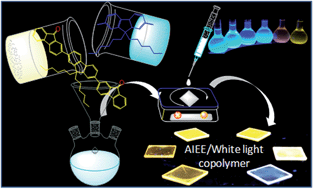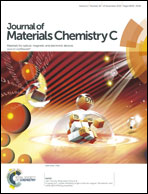Offsetting the problem of charge trapping in white polymer light-emitting diodes using a fluorenone-based luminogen†
Abstract
In this study, we propose a strategy to offset charge trapping and to enhance the confinement of excitons in the emissive layer of white electroluminescent copolymer using a luminogen with aggregation-induced emission enhancement (AIEE). The fluorenone-based luminogen, 2,7-bis(9H-fluoren-9-one-2yl)-9,9-dihexylfluorene (FF) that exhibited yellow emission with AIEE property is copolymerized with 9,9-dihexylfluorene in different compositions to tune the emission color. White-light emission is demonstrated in a copolymer FF-0.25, which contained 0.25% of FF in the polymer backbone. Interestingly, the copolymers exhibited enhanced emission upon aggregation in thin film, even in low FF composition. OLEDs fabricated from the copolymer FF-0.25 elicited a white electroluminescence with Commission Internationale de l'Eclairage (CIE) coordinates of 0.30, 0.31 with a power efficiency of 4.12 lm W−1. FF-0.25 showed very low charge trapping compared to other white emitting single polymer OLEDs reported to date. The reduced charge carrier trapping is attributed to the positioning of energy levels in the copolymer that resulted in almost equal electron- and hole-injection barriers. A theoretical investigation on the copolymers of FF revealed the presence of an ambipolar property and low exciton binding energy implicit of efficient formation and confinement of excitons within the emissive layer. The system represents the first ambipolar white electroluminescent polymer designed by using an AIEE luminogen.

- This article is part of the themed collection: JMC C Top Picks collection: Recent progress in light emitting diodes

 Please wait while we load your content...
Please wait while we load your content...